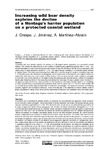Mostrar o rexistro simple do ítem
Increasing Wild Boar Density Explains the Decline of a Montagu’s Harrier Population on a Protected Coastal Wetland
| dc.contributor.author | Crespo, Jorge | |
| dc.contributor.author | Jiménez Pérez, Juan | |
| dc.contributor.author | Martínez-Abraín, Alejandro | |
| dc.date.accessioned | 2021-10-29T08:58:31Z | |
| dc.date.available | 2021-10-29T08:58:31Z | |
| dc.date.issued | 2021-07-19 | |
| dc.identifier.citation | Crespo, J., Jiménez, J., Martínez–Abraín, A., 2021. Increasing wild boar density explains the decline of a Montagu's harrier population on a protected coastal wetland. Animal Biodiversity and Conservation, 44.2: 229–239, DOI: https://doi.org/10.32800/abc.2021.44.0229 | es_ES |
| dc.identifier.issn | 1578-665X | |
| dc.identifier.issn | 2014-928X | |
| dc.identifier.uri | http://hdl.handle.net/2183/28766 | |
| dc.description.abstract | [Abstract] We studied the rapid decline in the number of breeding pairs (geometric growth rate λ = 0.86; 14 % annual decrease) of a semi–colonial ground–nesting bird of prey, the Montagu's harrier (Circus pygargus), after twelve years of rapid population growth (λ = 1.15; 15 % rate of annual increase) in a protected coastal wetland in Eastern Spain. The study was conducted from 1992–2017, and the range of values in population size was: 2–37 breeding pairs. We contrasted 20 biologically–sound hypotheses (including local and regional factors) to explain the trend over time in the annual number of pairs. The most parsimonious model included a surrogate of wild boar (Sus scrofa) density in the region during the previous year and the annual number of Montagu's harrier pairs breeding inland in the study province during the focal year. Syntopic western marsh harriers (C. aeruginosus) were not found to have any effect on the numbers of Montagu's harriers either in our modelling or when we performed a quantitative and qualitative study both for years t and t–1. Our final 'best' models did not include spring rainfall, regional forest fires or local land use changes. The impact of wild boars on breeding success, together with conspecific attraction, could have resulted in the dispersal of coastal wetland birds to larger populations in dense inland shrub lands where levels of wild boar nest predation were more likely lower. | es_ES |
| dc.description.abstract | [Resumen] Hemos estudiado el rápido descenso del número de parejas reproductoras (tasa de crecimiento geométrico λ = 0,86; 14 % de disminución anual) de un ave semicolonial que nidifica en el suelo, el aguilucho cenizo (Circus pygargus), tras 12 años de rápido crecimiento demográfico (λ = 1,15; 15 % de tasa de aumento anual) en un humedal costero protegido situado en el este de España. El periodo de estudio fue 1992–2017, con un intervalo de valores del tamaño de población de 2–37 parejas reproductoras. Hemos contrastado 20 hipótesis razonables desde el punto de vista biológico (teniendo en cuenta factores locales y regionales) para explicar la tendencia del número anual de parejas. El modelo más parsimonioso incluyó un indicador de la densidad regional del jabalí (Sus scrofa) durante el año anterior y el número anual de parejas de aguilucho cenizo que se reprodujeron en el interior de la provincia del estudio, durante el año en cuestión. En nuestro modelo no se observó que el aguilucho lagunero occidental (C. aeruginosus) sintópico tuviera efecto alguno en el número de aguiluchos cenizos; tampoco lo tuvo en los análisis cuantitativos y cualitativos relativos a los años t y t–1. Las precipitaciones de primavera, los incendios forestales en la región y los cambios en el uso del suelo a escala local tampoco aparecieron en nuestros mejores modelos finales. Los efectos de jabalíes en el éxito reproductor, junto con la atracción de individuos conespecíficos, podrían haber provocado la dispersión de las aves de los humedales costeros a poblaciones más numerosas presentes en zonas arbustivas de interior, donde probablemente la depredación de nidos por jabalí sea inferior. | es_ES |
| dc.description.sponsorship | Xunta de Galicia; GRC2014/050 | es_ES |
| dc.description.sponsorship | Xunta de Galicia; ED431C 2018/57 | es_ES |
| dc.language.iso | eng | es_ES |
| dc.publisher | Museu de Ciències Naturals de Barcelona | es_ES |
| dc.relation.uri | https://doi.org/10.32800/abc.2021.44.0229 | es_ES |
| dc.rights | Atribución 4.0 Internacional | es_ES |
| dc.rights.uri | http://creativecommons.org/licenses/by/4.0/ | * |
| dc.subject | Ground–nesting birds | es_ES |
| dc.subject | Regional dynamics | es_ES |
| dc.subject | Protected wetlands | es_ES |
| dc.subject | Nest predation | es_ES |
| dc.subject | Circus pygargus | es_ES |
| dc.subject | Sus scrofa | es_ES |
| dc.subject | Aves que nidifican en el suelo | es_ES |
| dc.subject | Dinámica regional | es_ES |
| dc.subject | Humedales protegidos | es_ES |
| dc.subject | Depredación de nidos | es_ES |
| dc.title | Increasing Wild Boar Density Explains the Decline of a Montagu’s Harrier Population on a Protected Coastal Wetland | es_ES |
| dc.type | info:eu-repo/semantics/article | es_ES |
| dc.rights.access | info:eu-repo/semantics/openAccess | es_ES |
| UDC.journalTitle | Animal Biodiversity and Conservation | es_ES |
| UDC.volume | 44 | es_ES |
| UDC.issue | 2 | es_ES |
| UDC.startPage | 229 | es_ES |
| UDC.endPage | 239 | es_ES |
| dc.identifier.doi | 10.32800/abc.2021.44.0229 |
Ficheiros no ítem
Este ítem aparece na(s) seguinte(s) colección(s)
-
GI-GIBE - Artigos [83]






